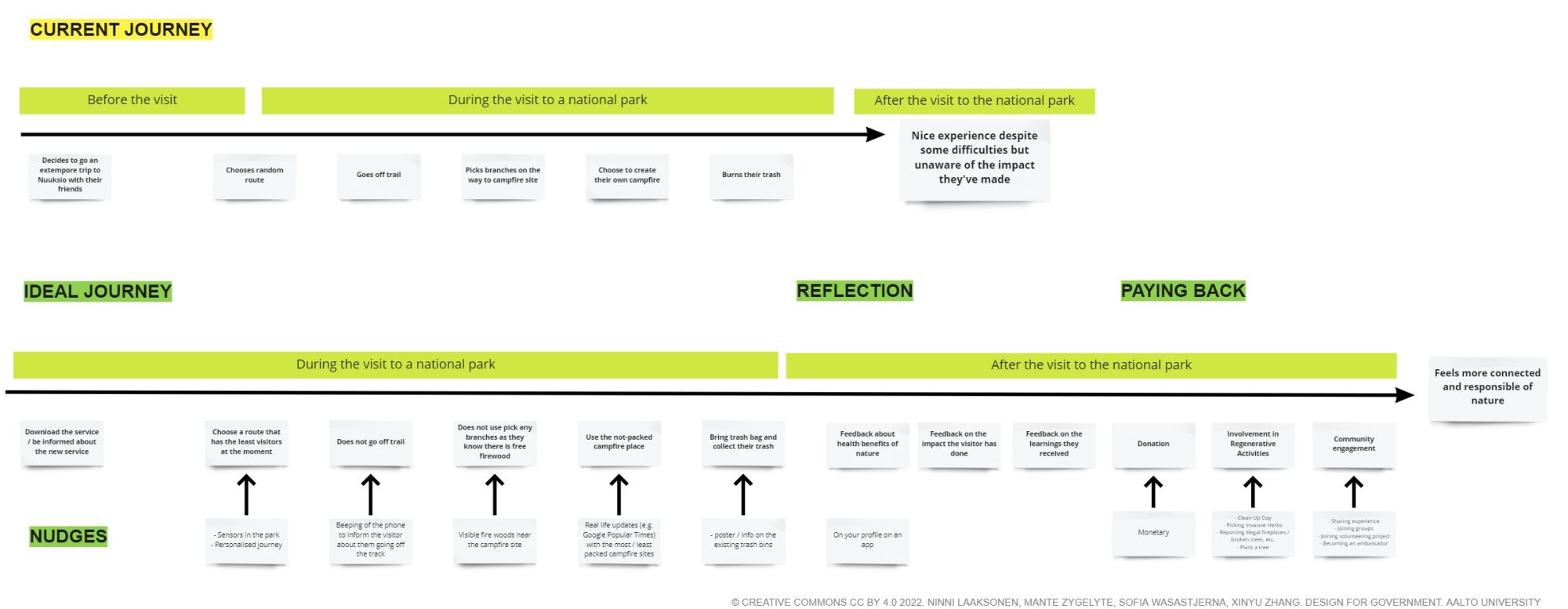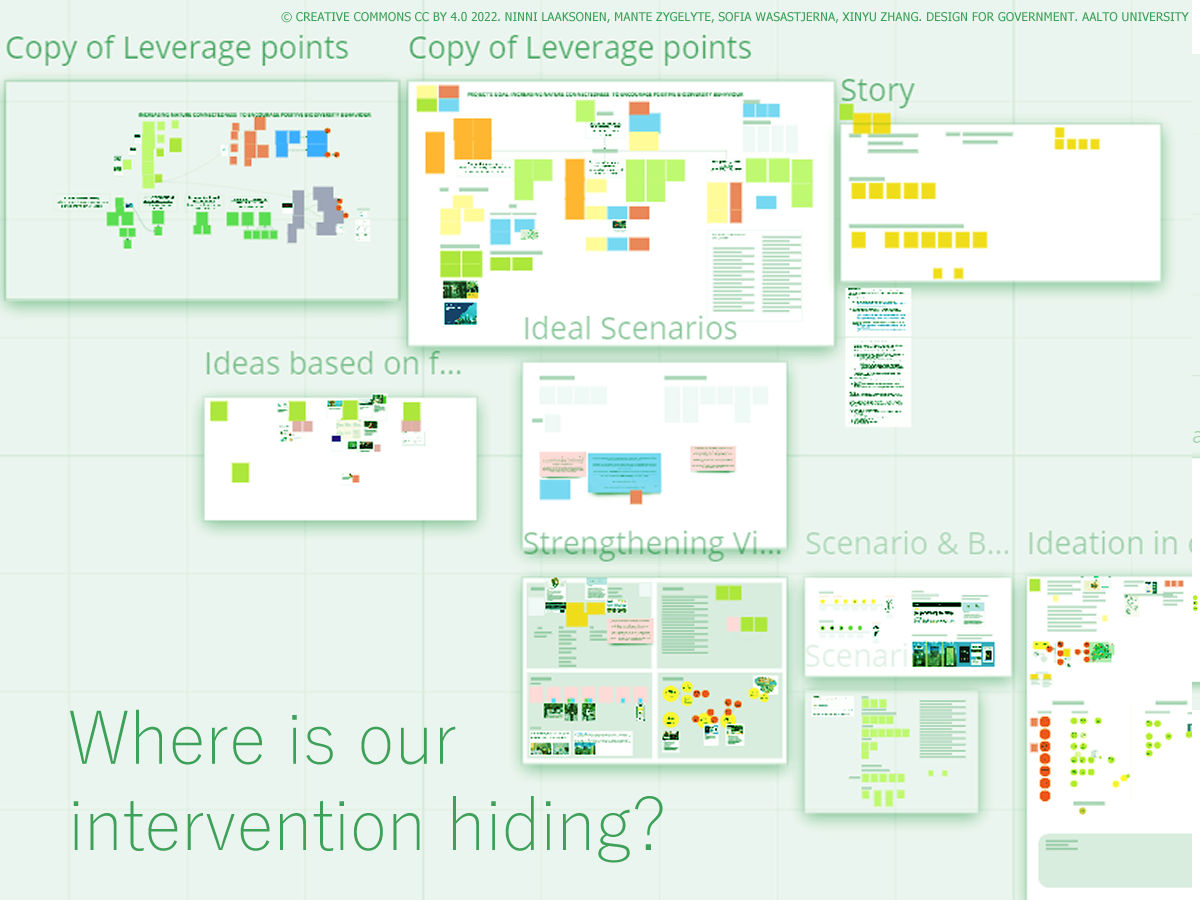This blog post reports on work-in-progress within the DfG course! The post is written by group 1B dealing with Metsähallitus’ and the Ministry of the environment’s brief on ‘the future of sustainable recreation’. The group includes Mantė Žygelytė, Ninni Laaksonen and Xinyu Zhang from Collaborative and Industrial Design program, and Sofia Wasastjerna from International Design Business Management program.
Written by: Ninni Laaksonen
Towards the intervention
Since our previous blog post, we have swiftly moved from our problem space – where we concluded with the most meaningful research insights, towards the solution space. This blog post will introduce our project ideal scenario, why we created it and how we’ll be using it as the basis of our design intervention.

Figure 1: Our scenario depicting the current and ideal journey
Let’s begin with our scenario by looking at the current visitors journey of the national park
“A group of friends and our protagonist Anna have planned on going on a spontaneous trip to one of Nuuksio park’s campfire sites. They break some twigs and branches from a nearby tree without thinking to use it in the fireplace. After arriving at their destination, they realize the campfire site is so crowded that they decide to start a fire on the ground, where someone had previously lit a small fire. Since they cannot find any bins, they decide to burn the paper trash and leave their uneaten food behind. They think it might be nice for the animals and bugs to eat and they didn’t think about bringing their own trash bag either. Overall, Anna’s Nuuksio park visit was nice, however, she is oblivious to the impact she and her friends have made during their short trip.”
This story, raises the question: “How could Anna’s journey be improved so that it would improve her experience, while also supporting and protecting the National park’s biodiversity?”
Breaking this question down even further, more thoughts arise regarding the different phases and aspects of a visit to a National Park that need to be considered:
Before
- Being informed in advance of practical information, recommendations and routes – how would Anna’s journey be different then?
During
- Information and instructions once entering the park – how could they help transform Anna’s trip into a learning experience that evoked empathy towards nature and wildlife?
- Supporting decision making while in the park – how can Anna more easily understand her impact on the park to better support her decisions while in the park?
After
- Takeaways and goals from a visit to the park – encouraging a deeper and empathic connection with nature, with an understanding of why national parks must be viewed differently from other forest areas.
- Disseminating the experience – Anna could share her successful experience with people and help educate them.
- Deepening the connection – Anna may continue to visit the park and potentially engage in regenerative activities, leading to her feeling more connection to nature.
Building the ideal future scenario
Our ideal scenario was made by describing the current behavior of actual visitors to national parks in the first part. This scenario was based on the insights from our research, in which we learned from the visitors of national parks and the current situation of Nuuksio’s infrastructure. To build a more holistic view of the relationship between the national park and the visitor, we looked into both the negative actions of visitors in the park and the aspects of the park itself that might lower the visitor’s experience. Could there be a correlation between why the visitors act a certain way in the park, and the infrastructure and information that’s easily missed in the current digital platforms and services?
Then, in the second half of our scenario, we imagined how the visitor journey could be improved. The thinking behind this part of the scenario is to spark ideas and raise the question: by which means can we achieve these desired goals? how can this scenario help us imagine what is needs to be designed? For example, as we presented this scenario in class, our peers shared their ideas on what could cater to the visitor’s needs, even though they weren’t working on the same project. The suggestions they offered varied from mobile notifications, maps with live data on the park, to tools that help the visitor plan their trip.
The suggestions from our peers also work as nudges, which can support and improve the outcomes for visitors of the national parks. Nudges are used to influence human choices and we as designers are the ones creating the context and environment to support the choices the visitors make (Thaler et al., 2016). The nudges we look to design for our project will take place during the first visit of a beginer type of visitor, since this kind of visit is usually the first touchpoint into the world of national parks. However, we cannot only focus nudging the “during” part of the visit, but also look into nudges that can lead to reflective and recreational activities even after the park visit and hopefully lead to a continuous and connected relationship with natural areas. Therefore, the nudges we look to develop have to do with:
1. Defaults: those actions people take which take the least amount of effort. In our context, choosing a campsite and route which are the most popular and seemingly easiest to access. How do we change it so that the default would be different from this?
2. Understanding mapping: makes tasks and decisions in the park easier for the visitors. Could there be a service or something in the infrastructure which would already recommend the perfect route for the visitor, thus making decisions a lot easier?
3. Feedbacks: refers to receiving immediate response to a good or bad action that the visitor takes. In our context it can be a notification on an app about health benefits the visitor has gained because of the visit to the park and being in nature.
What’s Next?
We are still in the process of determining what are the nudges we want to develop, and the creation of our ideal scenario has been quite helpful for this process. By next week, we aim to have our design intervention imagined and visualized, after which we’ll look towards its implementation. Looking back, I personally think the choices and findings we’ve made so far have led us towards finding a feasible problem area with real issues to be solved. Although sometimes the choices have been difficult, especially when choosing which insights we should tackle in our project, we resolved them by looking back into our briefs and research, then discussed within the group what were the most interesting insights. That, helped us form our thoughts better and decide on a path. Overall, our scope has stayed the same since our midterm presentation, which is to increase nature connectedness and encourage positive biodiversity behavior in the new visitor groups, and this continues to guide our project for the remaining of the course.
References
Thaler & Sunstein (2016). Choice architecture. ResearchGate. Chapter 25, 428-439.
The DfG course runs for 14 weeks each spring – the 2022 course has now started and runs from 28 Feb to 23 May. It’s an advanced studio course in which students work in multidisciplinary teams to address project briefs commissioned by governmental ministries in Finland. The course proceeds through the spring as a series of teaching modules in which various research and design methods are applied to address the project briefs. Blog posts are written by student groups, in which they share news, experiences and insights from within the course activities and their project development. More information here about the DfG 2022 project briefs. Hold the date for the public online finale online 09:00-12:00 AM (EEST) on Monday 23 May!

